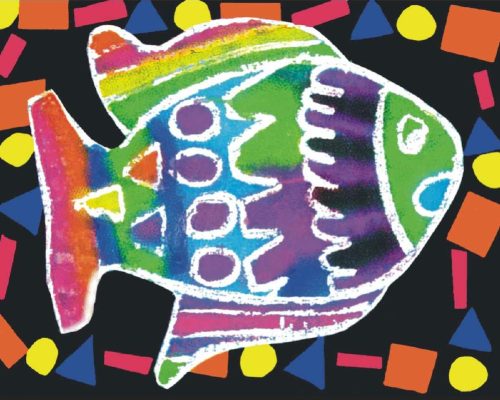Abstract Fish
National Standard II- of Student Interest/Ability/Needs

Correlation
National Standard I – Art Links to Broader Goals
- Using structures and function
- Making connections between visual arts and other disciplines.
Objectives
National Standard III – Content & Teaching of Art
- Artists draw best when they are familiar with their subject.
- Students will experience a selected subject through as many sessions as possible then draw it expressively emphasizing pattern.
Teacher Input
National Standard IV – Learning Environment
- Print – Japanese Fish Print – Gyotaku
- Print – African stylized design of fish – Art From Mary Hands Jo Miles Schuman, Davis Publications
- Research material on African Stylized Animals (1/group)
- Research material on Japanese Fish Print (1/group)
- Reference material – books and photos of variety of fish
- Display the Japanese and African print.
- Inquiry:
- Are these art?
- What do we need to know?
- Student response:
- Who produce the works?
- What are the images?
- When were they produced?
- How were they made?
- When were they made?
- Inquiry:
- Using a Venn diagram compare and contrast the two works, concentrating on the design elements, principles and the realistic vs. abstract qualities.
- Working in cooperative groups, pass out the research materials and discuss the purpose for each work and how they were made.
- Focus on the perceptual and realistic qualities and the conceptual and abstract qualities.
- Study reference materials.
- Students should identify the anatomical parts such as the scales, fins and gills. Where do you see patterns?
- Working in cooperative groups, pass out the research materials and discuss the purpose for each work and how they were made.
- Display an actual fish from the seafood market for the students to touch and smell.
- Examine closely for patterns and textures.
- Examine the anatomy.
- Proceed to link the fish and produce a print by placing a sheet of paper over the inked fish and rubbing.
- If time allows, students may produce a sketch of the fish.
- What if we made a fish in the African abstract style?
- How could we emphasize pattern?
- Have students create samples of patterns and lines.
Procedure
- Start the artwork. Draw and outline of a fish using the light blue or green 7” x 9” paper, stressing realistic qualities of size and proportion with oil pastels. Work should fill most of the paper.
- Fill the fish body with at least 9 different types of lines.
- Add pattern shapes between at least 5 of the areas.
- Fill in the areas with bright contrasting water colors. The more colors the better.
- Cut the fish out. Glue it onto the center of the black construction paper.
- Cut out and glue border pieces. Cut out various shapes, colors and sizes of construction paper pieces. Choose colors and shapes found in the fish. Glue these around the edge to form a border.
- Add finishing touches. Students should put their name on The front in white or another contrasting color, at least a 1″ away from the paper edge. Make sure the student’s name, grade/teacher and school are printed on the back of the artwork in pencil.
Evaluation
- Is your artwork complete?
- Explain the perceptual and realistic qualities or your artwork.
Explain the conceptual and abstract qualities of your artwork.
Age Group
Grades 3-5
Time
1-2 classes
Materials
- black construction paper
- light blue or green paper (approx. 7″ x 9″)
- various pieces of colored construction paper
- oil pastels
- fixative for pastels
- water color paints
- glue
- real or rubber fish

